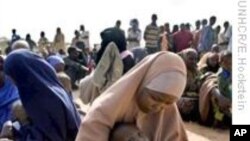The International Organization for Migration, the U.N. refugee agency and their partners say they have successfully completed the relocation of more than 13,000 Somali refugees from overcrowded camps in Kenya's northeastern region of Dadaab to Kakuma, in the northwest of the country. The emergency operation began in mid-August in an effort to ease the pressure on the heavily congested Dadaab camp complex.
Conditions for the Somali refugees who have been moved to Kakuma have changed for the better. But, for the hundreds of thousands of people left behind in Dadaab, virtually nothing has changed.
U.N. refugee spokesman, Andrej Mahecic, tells VOA while 13,000 refugees were moved from Dadaab to Kakuma, another 10,000 to 12,000 Somalis arrived in Dadaab. He says about 6,000 new refugees arrive in the camp every month.
"People are crossing into Kenya because of the situation in Somalia, because of the war and the drought and the famine there," Mahecic said. "So far this year, more than 50,000 people, 50,000 Somalis have crossed into Kenya ... The solution would to be to address the root causes of the refugee crisis. Somalia is one of the worst humanitarian situations in the world."
The Dadaab complex was built to hold 90,000 people, but hosts 280,000 refugees.
The U.N. High Commissioner for Refugees has been urging the Kenyan government to allocate more land for a new camp site. The negotiations have not moved beyond the talking phase.
The International Organization for Migration was in charge of transporting the 13,000 refugees from Dadaab to Kikuma. Spokesman, Jean-Philippe Chauzy describes the complex logistical arrangements IOM had to make to move the refugees across Kenya.
"It is a 1,200 kilometer journey across very difficult roads, very difficult terrain. There are some security issues too in the region of Dadaab, mostly due to shiftas, local bandits," Chauzy said. "IOM set up the logistic for this operation. We had about 20 different convoys that left Dadaab in mid-August to take people all the way across the country to Kakuma."
Chauzy tells VOA the trip from Dadaab to Kikuma takes about three days. He says arrangements were made for people to spend two nights in special shelters set up along the route so they could recover from the arduous journey.
He says IOM also flew about 300 vulnerable refugees, mainly young women, infants and elderly to their new camp. He says the Somalis are now enjoying better shelter, improved access to basic services, enhanced care and protection than they did in Dadaab where conditions remain dire.





